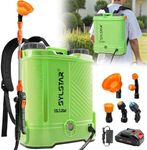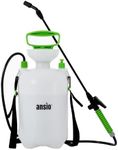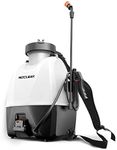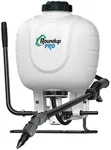Buying Guide for the Best Garden Sprayers
Choosing the right garden sprayer can make your gardening tasks more efficient and enjoyable. A garden sprayer is a tool used to apply fertilizers, pesticides, herbicides, and water to plants. The right sprayer can help you cover large areas quickly and evenly, ensuring your plants get the care they need. When selecting a garden sprayer, consider the size of your garden, the type of plants you have, and the specific tasks you need the sprayer for. Understanding the key specifications will help you make an informed decision.CapacityCapacity refers to the amount of liquid a sprayer can hold. This is important because it determines how long you can spray before needing to refill. Sprayers come in various sizes, from small handheld models with a capacity of 1-2 liters, suitable for small gardens or indoor plants, to larger backpack or wheeled models that can hold 15-20 liters, ideal for larger gardens or extensive spraying tasks. Choose a capacity that matches the size of your garden and the frequency of your spraying tasks. If you have a large area to cover, a larger capacity will save you time and effort.
Type of SprayerThere are several types of garden sprayers, including handheld, backpack, and wheeled sprayers. Handheld sprayers are lightweight and easy to use, perfect for small gardens or spot treatments. Backpack sprayers are worn on the back and are suitable for medium to large gardens, offering more capacity and comfort for longer tasks. Wheeled sprayers are ideal for very large areas, as they can hold more liquid and are easier to maneuver over long distances. Consider the size of your garden and your physical comfort when choosing the type of sprayer.
MaterialThe material of a garden sprayer affects its durability and weight. Common materials include plastic, stainless steel, and brass. Plastic sprayers are lightweight and affordable, but may not be as durable as metal options. Stainless steel and brass sprayers are more durable and resistant to corrosion, making them suitable for frequent use and harsh chemicals. If you need a sprayer for occasional use, a plastic model may suffice. For regular or heavy-duty use, consider investing in a metal sprayer for longevity.
Nozzle TypeThe nozzle type determines the spray pattern and coverage. Adjustable nozzles allow you to change the spray pattern from a fine mist to a direct stream, providing versatility for different tasks. Fixed nozzles offer a consistent spray pattern, which can be beneficial for specific applications. If you need flexibility for various tasks, an adjustable nozzle is a good choice. For consistent applications, such as applying a specific pesticide, a fixed nozzle may be more suitable.
Pressure MechanismThe pressure mechanism in a garden sprayer affects how the liquid is dispensed. Manual pump sprayers require you to build pressure by pumping, which can be labor-intensive but offers control over the spray. Battery-powered sprayers provide consistent pressure with less effort, making them ideal for larger areas or frequent use. Consider how much effort you are willing to exert and the size of your garden when choosing the pressure mechanism. For small gardens or infrequent use, a manual pump may be sufficient, while larger gardens may benefit from a battery-powered option.












![HOZELOCK - Pressure Sprayer Standard 5L : Versatile, Easy-to-use Sprayer, Ideal for Water-based Solutions (Insecticides, Fungicides, Weedkillers, Fertilisers), 20cm Lance [4230 0000]](https://images-proxy.bestreviews.guide/npuf7yl0LyUa88nvTyB3kMfDoWA=/0x150/https://m.media-amazon.com/images/I/31dC7LHjY2L._AC_CX679_.jpg)
![HOZELOCK - Pressure Sprayer Pulsar Plus 12L : Ideal for Large Gardens, Combines Practicality, Safety and Comfort, Separate Carrying Handle, Multi-jet Nozzle, 60cm Aluminium Lance [4312 1240]](https://images-proxy.bestreviews.guide/wSAK4_gAU-JIDVtqU6cqWk4z-RQ=/0x150/https://m.media-amazon.com/images/I/31rBuKY67xL._AC_CX679_.jpg)



